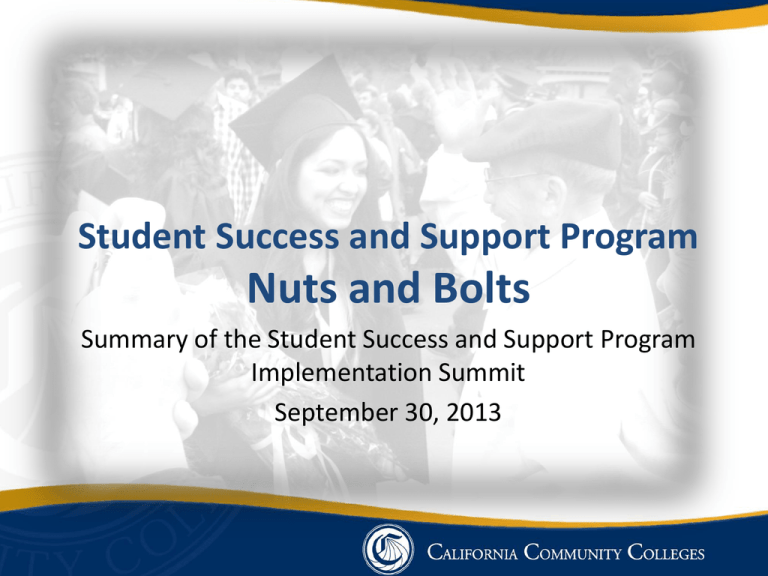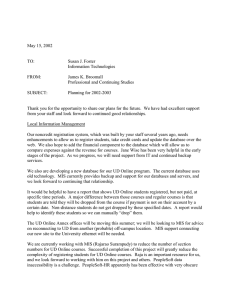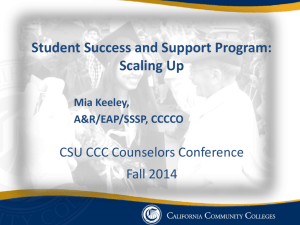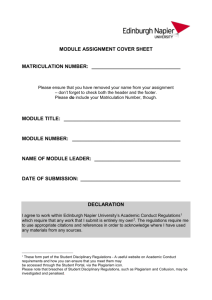Nuts and Bolts Student Success and Support Program Implementation Summit
advertisement

Student Success and Support Program Nuts and Bolts Summary of the Student Success and Support Program Implementation Summit September 30, 2013 Student Success and Support Program Planning and Implementation Timeline Fiscal Year 2012-13 System-level Planning Year: • Implementation workgroups convened October 2012 to develop proposals for title 5 Matriculation revisions, new allocation formula, & revised MIS data elements & definitions • New program planning & budget process developed • SB 1456 effective January 1, 2013 Fiscal Year 2013-14 District/College-level Planning Year: • Allocations based on enrollment only, new formula not applied • Funding targeted to core services (1-year exemption permitted by request) • Develop program plans • Implement MIS changes to ensure accurate and complete data reporting • Regulations effective October 19, 2013 • Convene noncredit work group Fiscal Year 2014-15 District/College-level Implementation Year 1: • Program plans and budgets submitted • Continue to ensure accurate and complete data reporting • Allocations based on enrollment only, new formula not applied • First legislative implementation report due July 1, 2014 (biannually thereafter) Fiscal Year 2015-16 Implementation Year 2: • FY 15-16 allocations based on 14-15 yearend data reported • Application of funding formula begins this year • 80% of prior year funding guaranteed Fiscal Year 2016-17 Implementation Year 3: • FY 16-17 allocations based on 15-16 year-end data reported • 50% of prior year funding guaranteed (returns to 95% thereafter) • Legislative report due July 1, 2016 Matriculation Student Success and Support Program • Known as the Matriculation Program Now called the Student Success and Support Program • 8 funded components 3 funded core services: orientation, assessment, counseling, advising, and other student education planning services • Colleges required to provide core matriculation services, but students not required to complete them Institutional AND student requirements Incentivizes student completion of core services • Stand-alone program planning Clear link to student equity planning • Funding allocated based on enrollment data for new and continuing students Funding formula includes services provided as well as enrollment • Incomplete data reporting on matriculation services Data required for funding Linked to Student Success Scorecard Student Success and Support Program Scope and Intent …Student Success is the responsibility of the institution and student, supported by well-coordinated and evidence based student and instructional services to foster academic success. Title 5, Section 55500 Student Success and Support Program Reporting Requirements • • • • Student Success and Support Program Plan Mid-Year Report (Declaration of Unused Funds) Year-End Expenditure Report Management Information System (MIS) data reporting New Credit Funding Formula Factors: • Number of Credit Students at Each College • Number of Students Who Received: • • • • • Orientation Assessment Counseling Advising Other Educational Planning Services SB 1456 Student Success and Support Program Credit Funding Formula College’s Potential Population of Students to Receive Services Students Served at the College Initial Orientation (SS06)** 10% Unduplicated Credit Student Headcount* Base Funding Floor $35K or 10% Initial Assessment (SS07)** 10% (academic year = summer, fall, winter, spring) (whichever is greater) Abbreviated SEP (SS09)** 10% College Match 3:1*** Counseling/Advising (SS08) 15% Comprehensive SEP (SS09) 35% At Risk Follow-Up Svc (SM10) 15% 40% *Includes CA resident students enrolled as of census in at least 0.5 credit units, (STD7) headcount status “A,” “B,” “C,” excludes special admits Other Follow-Up Svc (SM11) 5% 60% **Include pre-enrollment services provided for students with SB record ***Match may include A&R, & SSSP related technology & research Allowable Expenditures for College Match • Credit program requires 3:1 match Noncredit program requires 1:1 match • Matching funds must directly benefit SSSP, such as: – – – – – – Orientation Assessment for Placement Student Education Planning Counseling and Advising Follow Up Services Institutional Research and Technology directly related to provision of core services – Admissions and Records MIS - Student Success Data File • New Data File (SS) • Optional for 2013-14, Mandatory for 2014-15 • Current Matriculation Data file (SM) will be collected thru academic year 2013-14. • MIS will be offering a follow-up webinar in October 2013 with more detailed discussion on the individual SS data elements. Who Counts and When? • Every credit and noncredit student who: – enrolled in at least one class as of first census or later for daily or weekly census classes, or – attended at least one meeting of a positive attendance class, or – enrolled in at least one class that resulted in a notation on the student’s official record, or – received pre-enrollment matriculation services. • Services reported in term received What Does It Mean for Students? • Assessment, Orientation, Initial SEP (preferably with educational goal and course of study) required for priority registration • 100 unit threshold for priority registration • Good academic standing required for continued priority registration What Does It Mean for Us? • Updating and validating MIS coding • New deadlines for priority registration • New appeals processes for loss of priority registration • New exemption waiver process for assessment, orientation, and I-SEP • Updating priority registration groups What Does It Mean for Us? (cont’d) • Updating board policies in conjunction with LPC and District • Updating Banner holds in conjunction with LPC • Campus-wide collaboration to design innovative, research-based success interventions What We Propose A. Assessment, Orientation, and I-SEP mandatory for all students, with registration hold to enforce rule B. Create deadlines for priority registration assignment (April 1 for Fall 2014) C. Email every applicant W number and next steps email within 24 hours of application What We Propose D. Require orientation prior to assessment E. Create large-scale, first-year experience learning communities on campus F. Create campus-wide atmosphere where student success is expected Timeline • October - November 2013: Planning – Sequence of services, SEP development, schedules – Registration and Enrollment • Availability of application • Cutoff for mandatory services? – Enrollment Management • Student centered scheduling • Class availability • Basic Skills – Academic Standing Registration Changes/Appeals Timeline • October - November 2013: Planning – Analyze budget considerations • Core services (orientation, assessment, counseling, advising, and educational planning) and broad array of service delivery mechanisms, including at risk student interventions • Limits to funding – must be SSSP if on budget • December 2013 –January 2014 – Initial draft of SSSP Plan – Notify students of changes (+70 units/AP/PP) – Finalize plans for mandatory service delivery Timeline • January – March 2014 – Testing and practice runs for : • Software, interfacing, and technology • Messaging materials • Pathways between SARS, Banner, and MIS Data Elements • Hiring and Staffing • Review appeals process • Analyze programs for outcomes (baseline) Timeline • March 2014 – SSSP plan is final and moving through approval (needs to be at Board level by April/May) – Continue trial runs while collecting feedback from students, staff, faculty, and programs – Analyze for accuracy, efficiency, and student wellbeing • April 2014 – Sort students according to new reg priorities (resolve appeals prior to registration) Timeline • May 2014 – Process Analysis for Improvement – SSSP Plan is final and approved for submitting to CCCCO • Summer 2014 – 2014-15 Budget final – Continue to ensure accurate data reporting • Ongoing – Appeals, intervention strategies, student notifications, mandatory services, workshops, training and professional development For Additional Seminar Information and Materials http://www.3cmediasolutions.org/services/SSSP13/live




